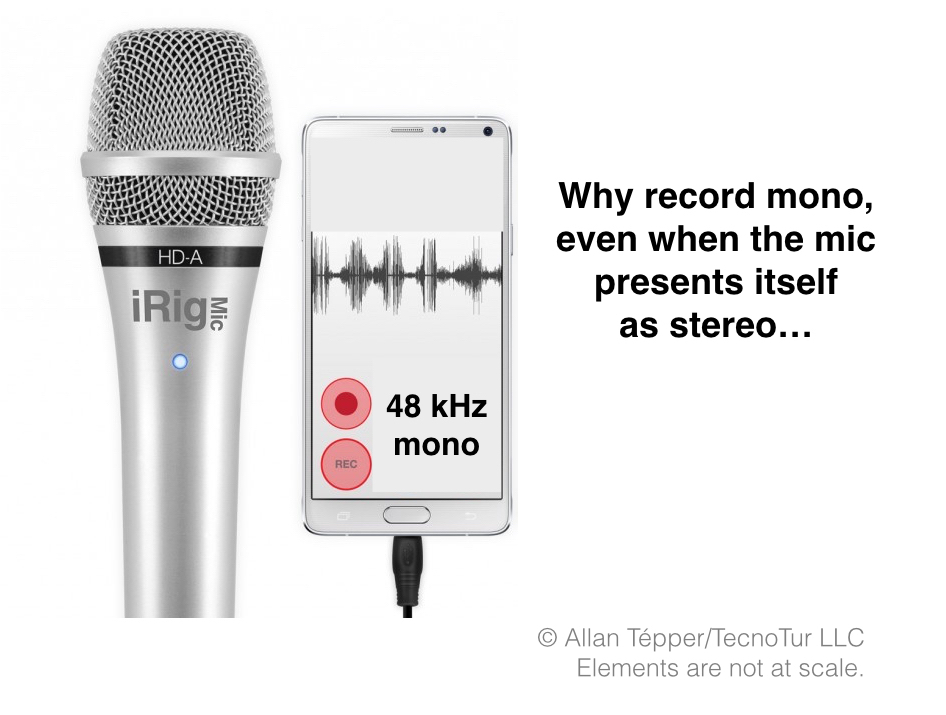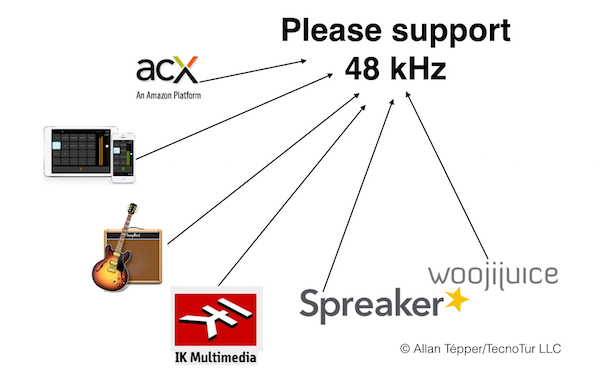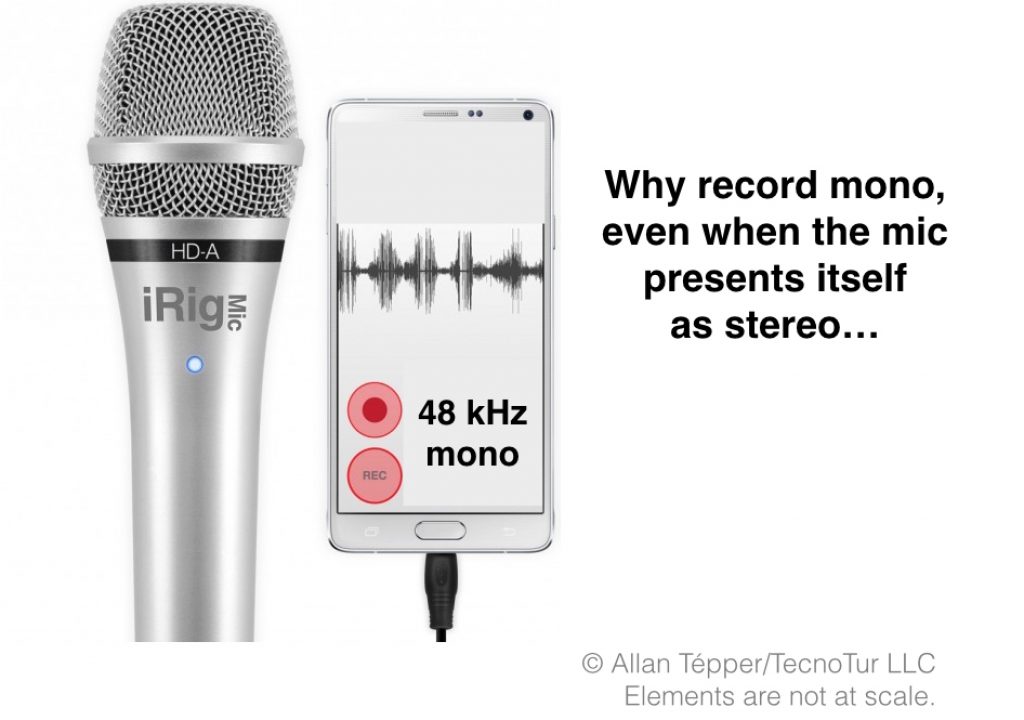
As I have shown in many past articles, there are many mono (i.e. non-stereo) digital mics that can be connected directly to your smartphone or tablet digitally, thereby bypassing the phone or tablet’s typically inferior preamp and A-to-D (analog to digital) converter. The same applies if you connect an analog mic (via digital converter) or audio mixer (traditional or automatic) with digital output or via an external digital converter to your smartphone or tablet. This article explores many reasons why we are often better served by making the raw recording in mono, even if your final show is to be in stereo. It also covers mobile audio recording apps that permit recording mono from the many digital mics that misrepresent themselves, presenting themselves as stereo when they are really mono, and those that given that situation sadly force us to record “stereo”, whether we like it or not.
In case you are wondering, the mic illustrated in the main image of this article is the iRig Mic HD-A (reviewed here)

and used to record the video in my very recent Branded windscreen vs mic flag: let’s compare , illustrated above), is the version that includes the special USB OTG cable that works with some Android devices, and a standard USB-A cable for connecting to desktop computers and laptops. The original version of this mic is called iRig Mic HD (reviewed here) officially includes a Lightning cable for iOS devices (iPad/iPhone/iPod Touch) and a standard USB-A cable for desktop computers. The original version (which is now discounted to under US$100 on some sites) officially does not include the special USB OTG cable. However, at least one end-user review listed there indicate that the original one of the mic now includes the special USB OTG cable too. Your mileage may vary.
Advantages of mono recording, even if the final show will be stereo
If you are making an audio-only recording from a single mono microphone to be edited later, there are at least four important advantages to record in mono (monophonic) instead of stereo (stereophonic), even if your final show will be in stereo (due to stereo music and effects):
- The raw audio file will take half of the space it would have taken in your own computer or mobile device, which doubles your available space. If you have 4 hours remaining for recording mono, you would only have 2 hours left for a forced stereo recording.
- When sending that raw audio file via Internet to be edited later, it will weigh half and it will arrive to the destination much faster. If you have a data plan that is not unlimited, has a cap… or they charge you for measured traffic, recording in mono is a way of economizing bandwidth without sacrificing quality. If you are using DropBox, Google Drive or a similar service, it will consume half the space on that service. If you use SFTP (secure FTP), it will consume half of the space there.
- Sometimes when people record using certain stereo interfaces, it ends up with an empty audio channel if a single mic is connected to a single input. The empty channel can contain noise and can cause some editing programs to interpret it as stereo. In that case, the operator/editor would have to eliminate that channel manually later (extra work) and might neglect to do so (potentially reducing quality).
- It doesn’t matter if the final show may be stereo: the original recording of your voice can —and should— be mono if it comes from a single microphone. During the editing (if esthetically appropriate), the mono voices will end up on both sides (right and left) of the stereophonic image.
The only possible exception to the above is if you want to do audio bracketing, where an identical recording is made at a lower level, as a safety in case someone unexpectedly screams and causes the audio to peak. However, this technique doesn’t apply with any of the many digital microphones I have tested to date when recording on mobile devices, since I haven’t found any that will allow bracketing with any app I have seen so far for Android or iOS when connected to a mono digital mic.
Of course, this does not apply at all if you are broadcasting live or recording live-to-drive, which is something that both Bossjock Studio (reviewed here) and Spreaker Studio allow. In those cases, your show recording will be stereo and will include the stereo music and effects, and that is something I applaud about those apps, since they are indeed designed for creating the final show on the fly, not for recording raw clips to be edited later. Those can be pre-edited and pre-produced in advance of the live show, and then be imported into either of these apps as a pre-recorded audio package.

However, I must remind you that as of publication time of this article, sadly neither the Bossjock Studio app nor Spreaker Studio apps allow 48 kHz recordings, despite my private requests and an open letter where they were both listed as recipients, All audio production & distribution should go 48 kHz. Learn why., which is illustrated above. Fortunately, many other apps for Android and iOS do support 48 kHz recording, including all of the ones listed in the next section of this article.
Android mobile apps and their mono/stereo/multitrack capabilities
Auphonic for Android (reviewed here) fortunately allows us to record mono, even with a digital mic that presents itself as stereo. (Auphonic for Android also offers stereo recording capabilities.)
USB Audio Recorder PRO for Android (reviewed here and here) allows us to record mono, even with a digital mic that presents itself as stereo to the system. (USB Audio Recorder PRO for Android also offers stereo and even multitrack recording for use when connected with an appropriate device.)
iOS mobile apps and their mono/stereo capabilities
As of publication date of this article, Auphonic for iOS (reviewed here) sadly forces us to record stereo when it has selected a mono digital mic that presents itself as stereo. However, Auphonic has told me that it will add the mono option in a future update.
RØDE Rec for iOS (reviewed here) fortunately allows us to record mono, even when it has selected a mono digital mic that presents itself as stereo. (It can also record stereo.) RØDE Rec for iOS is used by voiceover talent Dmitri Michas, as indicated in the review.
As of publication date of this article, ShurePlus MOTIV Mobile Recording app for iOS (reviewed here and here) sadly forces us to record stereo when it has selected a mono non-Shure digital mic. This app only allows the option to record mono from a Shure digital mics. The company has replied that it won’t comment on possible future updates to the app.
Although I have not tested it personally to date, Melvin Rivera Velázquez of Cambio 180 uses and endorses TwistedWave for iOS. According to the response I received from the developer’s customer support, TwistedWave for iOS fortunately gives us the choice of recording mono, even when it detects a stereo digital source. (It can also record stereo.)
Upcoming articles, reviews, radio shows, books and seminars/webinars
Stand by for upcoming articles, reviews, and books. Sign up to my free mailing list by clicking here.
Si deseas suscribirte a mi lista en castellano, visita aquí. Si prefieres, puedes suscribirte a ambas listas (castellano e inglés).
Listen to his CapicúaFM show at CapicúaFM.com in iTunes or Stitcher.
FTC disclosure
No manufacturer is specifically paying Allan Tépper or TecnoTur LLC to write this article or the mentioned books. Some of the other manufacturers listed above have contracted Tépper and/or TecnoTur LLC to carry out consulting and/or translations/localizations/transcreations. Many of the manufacturers listed above have sent Allan Tépper review units. So far, none of the manufacturers listed above is/are sponsors of the TecnoTur programs, although they are welcome to do so, and some are, may be (or may have been) sponsors of ProVideo Coalition magazine. Some links to third parties listed in this article and/or on this web page may indirectly benefit TecnoTur LLC via affiliate programs.
Copyright and use of this article
The articles contained in the TecnoTur channel in ProVideo Coalition magazine are copyright Allan Tépper/TecnoTur LLC, except where otherwise attributed. Unauthorized use is prohibited without prior approval, except for short quotes which link back to this page, which are encouraged!

Filmtools
Filmmakers go-to destination for pre-production, production & post production equipment!
Shop Now









